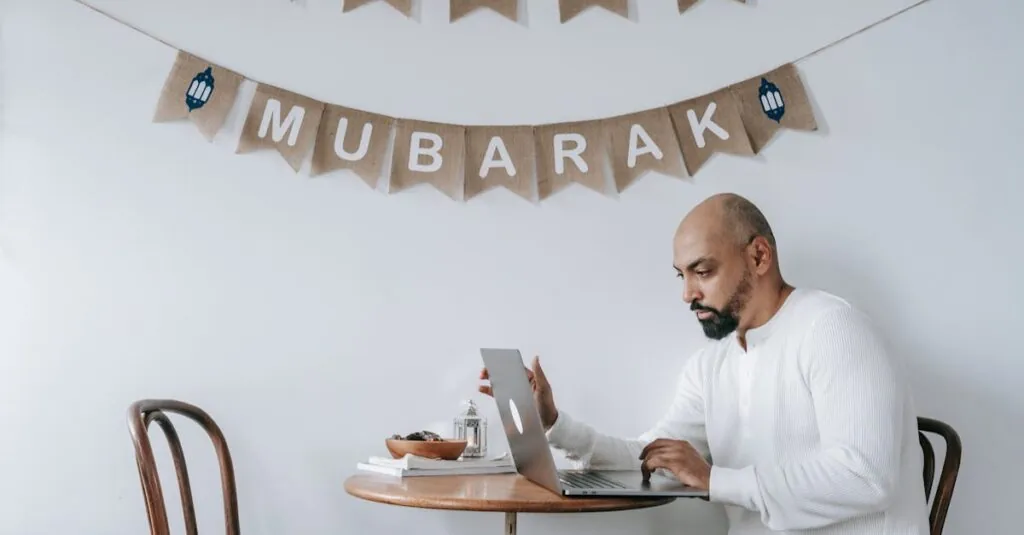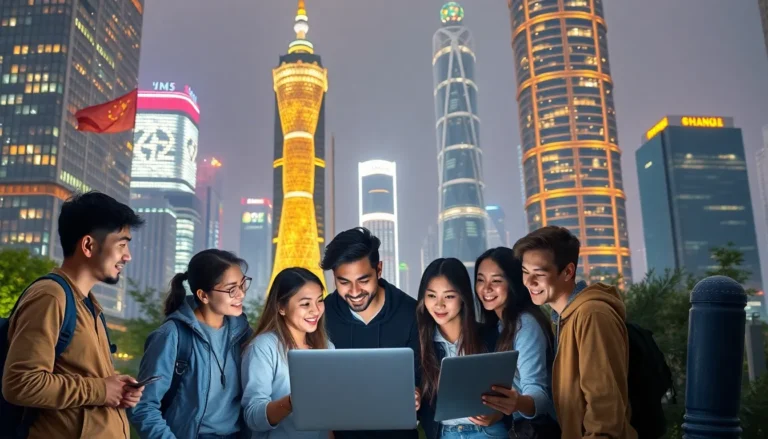In a world where the only constant is change, the online ritual shift is redefining how people connect, celebrate, and even grieve. Gone are the days when gatherings required physical presence. Now, virtual ceremonies are popping up like weeds in a garden, proving that you can toast to life’s milestones without ever leaving your couch.
This shift isn’t just about convenience; it’s about creativity. From Zoom weddings that make “I do” feel like a tech-savvy romance movie to online memorials that let loved ones share stories from afar, the digital landscape is transforming traditions in delightful ways. So grab your favorite snack and settle in—it’s time to explore how this online ritual shift is changing the game for good.
Table of Contents
ToggleUnderstanding Online Ritual Shift
Online rituals represent a notable transformation in how people engage with significant life events. This evolution highlights the growing acceptance and practice of virtual gatherings for various occasions.
Definition and Concept
Online ritual shift refers to the transition from traditional in-person ceremonies to digital platforms for celebrating, connecting, or mourning. These digital rituals often involve synchronous and asynchronous participation, allowing diverse groups to come together regardless of geographic boundaries. Virtual events include live-streamed weddings, memorials, and other significant milestones. Technology acts as a conduit for shared experiences, ensuring inclusivity and accessibility. Individuals can engage in real-time interactions or view recorded services, making participation possible for those unable to attend in person. This shift broadens the scope and purpose of rituals, redefining community connections.
Historical Context
Historically, rituals served as vital expressions of culture and belonging, often requiring physical presence. Community gatherings aimed to strengthen social bonds and celebrate pivotal moments. The emergence of digital communication transformed these norms, especially during the COVID-19 pandemic, when restrictions limited physical interactions. Early adopters began hosting online celebrations, including birthday parties and holiday gatherings, showcasing innovative use of technology. Increased engagement with digital platforms fostered growth in online rituals following the pandemic. As people recognized the value of virtual connectivity, acceptance of online ceremonies expanded, altering perceptions of tradition and community in modern life.
Factors Influencing Online Ritual Shift
Numerous elements contribute to the transition towards online rituals. These factors reshape how individuals engage in life events and ceremonies.
Technology and Digital Platforms
Advancements in technology play a vital role in the online ritual shift. High-speed internet and user-friendly software facilitate seamless connections for virtual events. Platforms like Zoom, Microsoft Teams, and social media applications enable participants to join celebrations regardless of location. Accessibility increases as devices become more affordable and widespread. Streaming services enhance the experience, allowing individuals to share moments in real-time. Users appreciate customization options, which help personalize online rituals. Security measures improve with encryption technologies, encouraging more people to embrace digital ceremonies.
Social Dynamics and Community Engagement
Social dynamics significantly influence the adoption of online rituals. Changes in societal norms drive individuals toward virtual interactions as preferred methods of connection. Communities have expanded beyond geographic boundaries, allowing diverse perspectives to enrich experiences. Shared interests often unite participants, fostering a sense of belonging in digital spaces. Events that were once exclusive to certain groups now welcome wider audiences. Enhanced engagement occurs through interactive features, such as chat rooms and live polls. Emotional connections remain strong, as participants can support each other despite physical distances. Social media platforms amplify outreach by promoting events, boosting community awareness, and facilitating new formations of connections.
Examples of Online Ritual Shift
Online rituals manifest in various forms, enhancing connections among individuals separated by distance.
Religious Practices
Virtual religious services have surged in popularity, with many congregations transitioning to online platforms. Online worship allows participants from different locations to gather in real time, forming communities despite physical barriers. Live-streamed sermons, interactive prayer sessions, and virtual study groups foster a sense of belonging and engagement. Some faith communities utilize social media for daily reflections or prayer requests, expanding outreach. Digital rituals like online baptisms or confirmations emphasize inclusion by allowing loved ones to join significant moments, enriching the spiritual experience.
Cultural Celebrations
Online cultural celebrations showcase diverse traditions, bringing people together across great distances. Virtual gatherings for holidays such as Diwali, Hanukkah, or Eid enable family members to share rituals and meals, even when apart. Creative online events include virtual dance parties, cooking classes, and art workshops, reflecting cultural heritage. Participatory elements like digital storytelling and live performances enhance the communal aspect of these celebrations. Engaging with cultural practices online encourages exploration and appreciation of different traditions, fostering a greater understanding among communities worldwide.
Implications of Online Ritual Shift
The online ritual shift significantly influences how individuals connect socially and relate to traditional practices.
Social Connections and Isolation
Online rituals bridge geographical gaps, fostering connections among individuals regardless of distance. Virtual events allow participation from various communities, reducing feelings of isolation for many. Shared experiences during online celebrations strengthen ties between friends and family, creating a sense of belonging. Tools like video conferencing enable real-time interaction, enhancing emotional connections among participants. Many people experience increased engagement through these digital formats as they can connect with those who might otherwise be unable to attend due to health or mobility issues.
Impact on Traditional Practices
The transition to online rituals challenges traditional practices and encourages innovative approaches to ceremonies. Established customs adapt to digital formats, allowing for flexibility in how they are celebrated. Many organizations and communities now integrate technology into important events, ensuring accessibility while preserving core elements of each ritual. Virtual platforms enable diverse expressions of culture and faith, redefining what constitutes a traditional celebration. Various groups embrace this shift, experiencing deeper connections and newfound meanings in their practices as they navigate the evolving landscape of digital rituals.
The online ritual shift is reshaping how individuals engage with significant life events. As technology continues to evolve, the ability to connect virtually will only strengthen. This transformation not only enhances accessibility but also enriches the experience of communal gatherings.
People are discovering new ways to celebrate and mourn together, demonstrating that physical distance no longer limits emotional closeness. The growing acceptance of digital rituals signifies a broader cultural shift that embraces innovation while honoring tradition.
As communities adapt to these changes, the future of rituals looks promising, paving the way for deeper connections and more inclusive celebrations across the globe.









